
Cryptocoryne is a genus of aquatic plants from the family Araceae. The genus is naturally distributed in tropical regions of India, Southeast Asia and New Guinea.
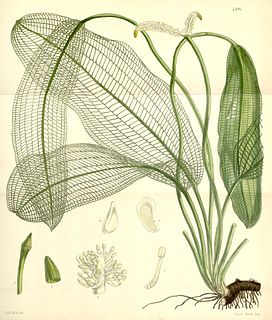
Aponogeton madagascariensis is commonly known as Madagascar laceleaf, lattice leaf or lace plant. It is an aquatic plant native to Madagascar, popularly sold for use in aquariums. It is endangered in the wild.

Hottonia palustris, also water violet or featherfoil, is an aquatic plant in the family Primulaceae.

Echinodorus cordifolius, the spade-leaf sword or creeping burhead, is a species of aquatic plants in the Alismatales. It is native to Mexico, the West Indies, Central America, South America and the southeastern United States.
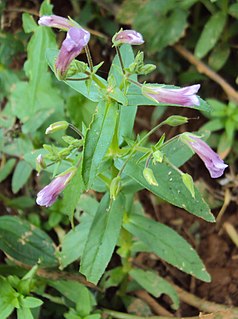
Limnophila aromatica, the rice paddy herb, is a tropical flowering plant in the family Plantaginaceae. It is native to Southeast Asia, where it flourishes in hot temperatures and grows most often in watery environments, particularly in flooded rice fields. It is called ngò ôm or ngò om or ngổ in Vietnam and used as an herb and also cultivated for use as an aquarium plant. The plant was introduced to North America in the 1970s due to Vietnamese immigration following the Vietnam War. It is called "ma om" (ម្អម) in Khmer. It is used in traditional Cambodian soup dishes and Southern Vietnamese cuisine. It can grow in flooded rice paddies during wet season but it grows best on drained but still wet sandy soil of harvested rice paddies for a few months after the rainy season ended. It dies out soon after it flowers. Rural Cambodians often harvest them and put them on the roof of their houses to dry for later use.
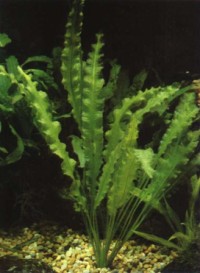
Aponogeton crispus is an aquatic plant species.

Crinum thaianum, Common name Thai Onion plant or Water onion, is an emergent plant species endemic to coastal plain of southern Thailand in Ranong and Phang Nga Provinces. Its natural habitat is along the banks of running streams, where its roots and bulb are submerged but the flowering holds the umbel of large, showy flowers above the surface. This natural habits make it a wonderful addition for tropical aquaria, and it is sold in many lands to be used in decorating displays of tropical fish. In nature, however, the species is threatened and diminishing in numbers due to habitat destruction.

Bolbitis heudelotii, also known as the African water fern, creeping fern, and Congo fern, is native to subtropical and tropical Africa, from Ethiopia west to Senegal; and down to northern South Africa.
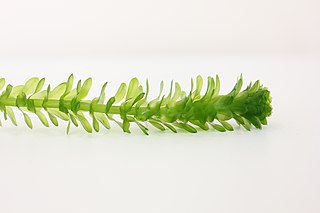
Egeria densa, the large-flowered waterweed or Brazilian waterweed, is a species of Egeria native to warm temperate South America in southeastern Brazil, Argentina, Chile and Uruguay. It is considered a problematic invasive species due to its use in home aquariums and subsequent release into non-native ecosystems.

Cardamine lyrata, known commonly as Japanese cress and Chinese ivy, is a species of aquatic plant in the mustard family. It is native to the marshes of eastern China and Siberia, as well as Korea and Japan. It flowers from May to June in the wild, with seeds ripening through September. The flowers are bisexual and are pollinated by insects, but are also self-fertile.

Cryptocoryne beckettii, also known as Beckett's water trumpet, is a plant species belonging to the Araceae genus Cryptocoryne.
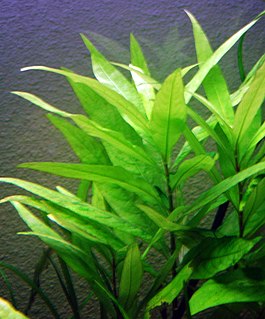
Hygrophila corymbosa, commonly known as temple plant, starhorn or giant hygro, is a riparian plant in the acanthus family.

Hygrophila polysperma, commonly known as dwarf hygrophila, dwarf hygro, Miramar weed, Indian swampweed or Indian waterweed, is an aquatic plant in the family Acanthaceae. It is native to Bangladesh, India, China and Malaysia, and has also been introduced to the US states of Florida, Texas and possibly Virginia. It is listed on the Federal Noxious Weed List in the US and is illegal to import and sell in a number of states including Kansas and South Carolina.

Cryptocoryne × willisii is a plant in the family Araceae.

Cryptocoryne wendtii, the Wendt's water trumpet, is a species of herb which is a popular aquarium plant which is native to Sri Lanka. It was described by Dutch botanist Hendrik de Wit in honour of aquarium hobbyist and writer Albert Wendt.

Vallisneria spiralis, also known as straight vallisneria, tape grass, or eel grass is a common aquarium plant that prefers good light and a nutrient rich substrate. In the wild, it can be found in tropical and sub-tropical regions worldwide.

Lilaeopsis is a genus of several species of flowering plants in the family Apiaceae. Known commonly as grassworts. L. brasiliensis is used as a decorative plant for the foreground of aquaria.
Lilaeopsis masonii is a species of flowering plant in the family Apiaceae known by the common names mudflat quillplant and Mason's lilaeopsis. It is endemic to California, where it is known only from the Sacramento-San Joaquin River Delta and nearby shores of San Francisco Bay.
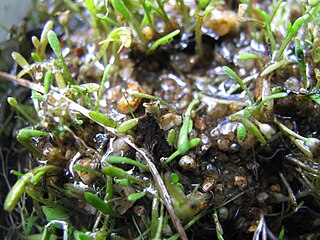
Glossostigma cleistanthum, also known as mudmat, is a freshwater aquatic plant native to Australia, New Zealand, India and East Africa. It is a cleistogamous plant, which is a type of self-pollinating plant that can propagate using non-opening flowers. Where growth is submerged, the leaves are between 0.5–2.5 inches long and bear closed, self-pollinating flowers. These leaves are nearly sessile and grow along the stem in alternating pairs that resemble rabbit ears. Where water recedes and growth is emergent, the leaves are much smaller, ranging between 0.2–0.5 inches in length. The emergent plants produce insect-pollinated flowers located on short stalks. It belongs to the family Phrymaceae which includes annuals and perennials.
Cryptocoryne parva is an aquatic freshwater plant, often grown in aquariums. It is the smallest known member of the genus Cryptocoryne. Native to Sri Lanka, it grows as a small rosette reaching between 5 - 8 cm. Emerse leaves are a little wider than those growing under water. The spathe is c. 1.5 cm.


















